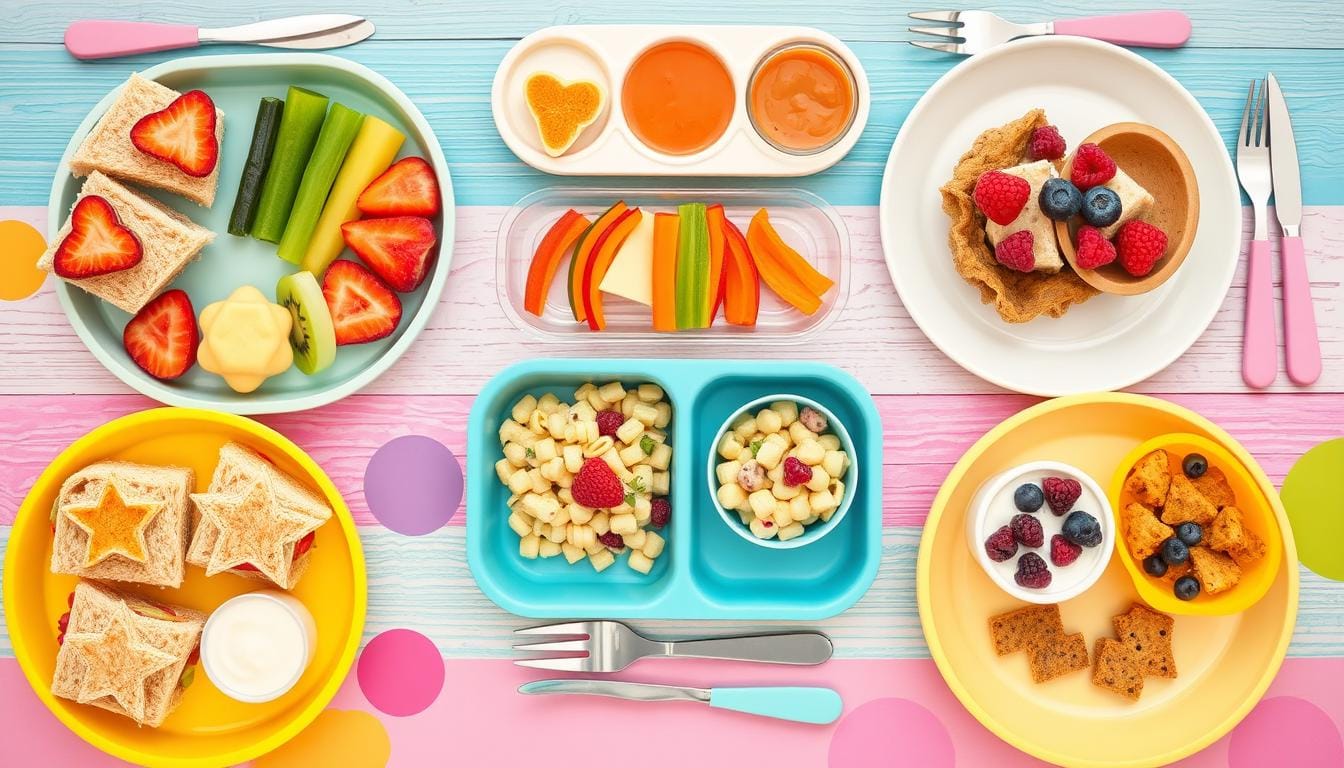Choosing nutritious and delicious lunches for toddlers can be challenging. Parents face busy schedules, picky eaters, and the need for easy meals. But don’t worry! We’ve got 10 healthy lunch ideas for toddlers that they’ll love.
These ideas include no-reheat meals for daycare and preschool, and fun finger foods. They’re not only good for your child but also easy to pack. Say goodbye to lunchbox blues and hello to happy, well-fed toddlers!
Key Takeaways
- Discover 10 healthy and appealing lunch ideas for toddlers
- Find no-reheat meal options suitable for daycare, preschool, and outings
- Learn tips for creating balanced, nutrient-rich toddler meals
- Explore solutions for common feeding challenges like picky eating
- Discover convenient and kid-friendly lunch packing strategies
Table of Contents
Understanding Toddler Nutrition Basics
As your little one starts eating solid foods, knowing about toddler nutrition is key. Toddlers, aged 1 to 3, need special foods for their fast growth and development.
Essential Nutrients for Growing Toddlers
Toddlers need many nutrients to grow well. They need protein, healthy fats, iron, calcium, and vitamin D. Protein helps build muscles, while healthy fats support brain growth. Iron is key for blood cells, and calcium and vitamin D are for strong bones.
Balanced Meal Components
For balanced meals for toddlers, mix different food groups. Include fruits, veggies, grains, protein, and dairy. This gives your child all the nutrients they need. Make sure to adjust portion sizes for kids based on their needs.
Portion Size Guidelines
Toddlers have small stomachs and need to eat often, every 2-3 hours. Toddlers should enjoy three meals and two snacks each day. For a 1-year-old, start with about 1/4 cup of each food group, increasing as they grow.
Learning about toddler nutrition helps you make healthy lunches. Use a variety of foods and the right portion sizes. This ensures your toddler gets a nutritious and satisfying lunch.
Why Healthy Lunches Matter for Toddler Development
Nourishing lunches are key for your toddler’s growth. They need balanced meals to grow strong, smart, and full of energy. Starting healthy eating habits early helps them stay well for life and avoids health problems later.
Toddlers need three meals and up to three snacks daily, every 2-3 hours. Their small stomachs need food often for growth. Older kids and teens eat three meals and one snack a day, with snacks less frequent.
A balanced diet is important, as the USDA MyPlate guidelines suggest. It should include protein, dairy, fruits, veggies, and whole grains. Meals should have four to five food groups, and snacks two to three.
Keeping a regular eating schedule helps kids eat well and avoid eating too much.
Toddlers and young preschoolers do best with meals and snacks every 2.5 to 3 hours. School-age kids need meals every 3 to 4 hours, and teens every 4 to 5 hours.
The 2021 survey showed many young kids don’t eat fruits or veggies daily. They also drink sugary drinks often. Giving your toddler healthy lunches can fill this gap and support their growth.
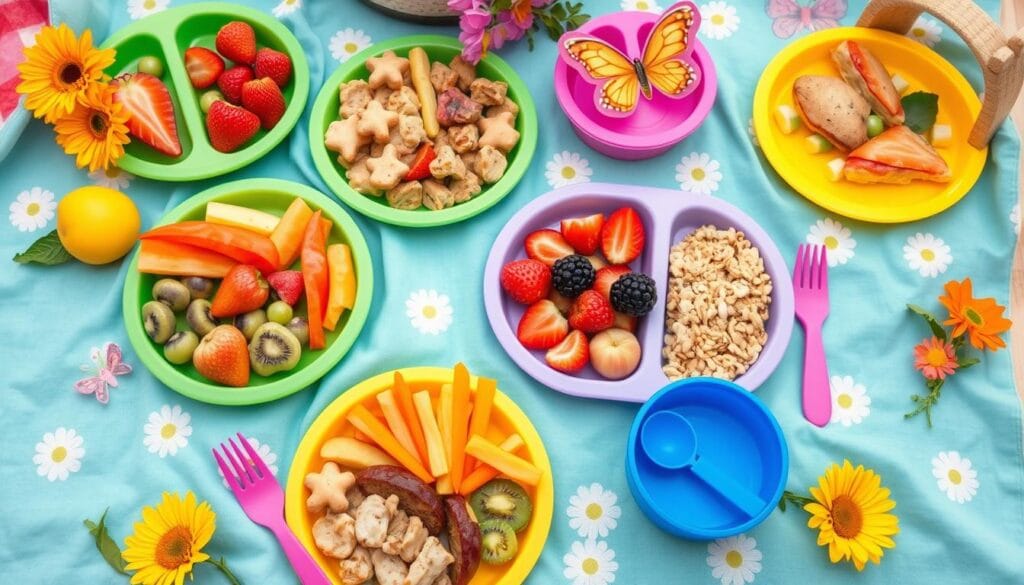
“Nutritious lunches are crucial for toddlers, supplying the key nutrients needed for growth, brain development, and sustained energy.”
Preparing Quick and Easy Lunch Ideas for Toddlers
As a busy parent, making lunch fast is crucial. It ensures your toddler gets healthy meals. With some smart tips and prep ahead, you can make quick toddler meals quickly.
Time-Saving Prep Tips
- Batch cook proteins, grains, and roasted veggies for easy lunch prep.
- Turn dinner leftovers into fun lunches for your toddler.
- Stock up on healthy items like canned beans, whole-grain crackers, and nut butter.
Make-Ahead Strategies
Preparing parts of lunch early can change the game for make-ahead lunches for kids. Here’s how:
- Make big batches of dressings, sauces, and dips for the week.
- Freeze individual portions of soups, stews, and pasta.
- Prepare sandwich fillings or wrap ingredients early and store them apart.
Storage Solutions
Get good storage containers for your toddler’s lunch. Bento boxes with sections are great for different foods. Airtight containers or reusable bags also keep things fresh.
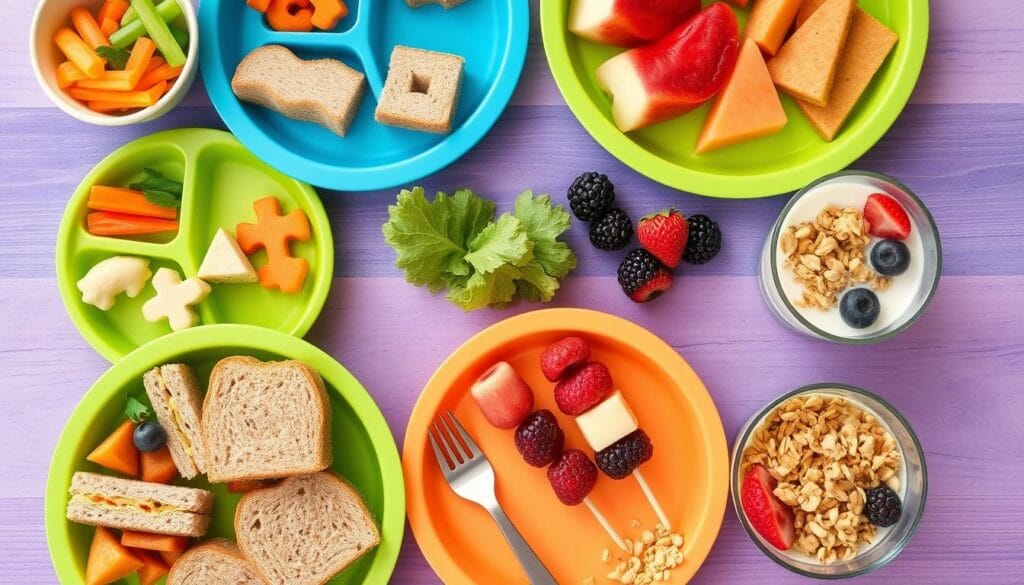
With a bit of planning, you can prep a week’s worth of quick toddler meals. This makes lunchtime easy for you and your little one.
Fun and Creative Ways to Present Toddler Meals
Presentation matters a lot when it comes to toddlers eating. Try these fun ideas to make mealtime exciting for your little one.
Turn sandwiches into fun shapes using cookie cutters. Cut out stars, hearts, or circles. You can also cut off the crusts to make them easy to eat.
Make fruits and veggies colorful and fun. Try “ants on a log” with celery, nut butter, and raisins. Or arrange sliced bell peppers, cherry tomatoes, carrot sticks, and blueberries in a rainbow pattern.
Bento-style lunch boxes are great for creative toddler food ideas. They have multiple compartments for different foods. This makes mealtime fun and helps your toddler try new things.
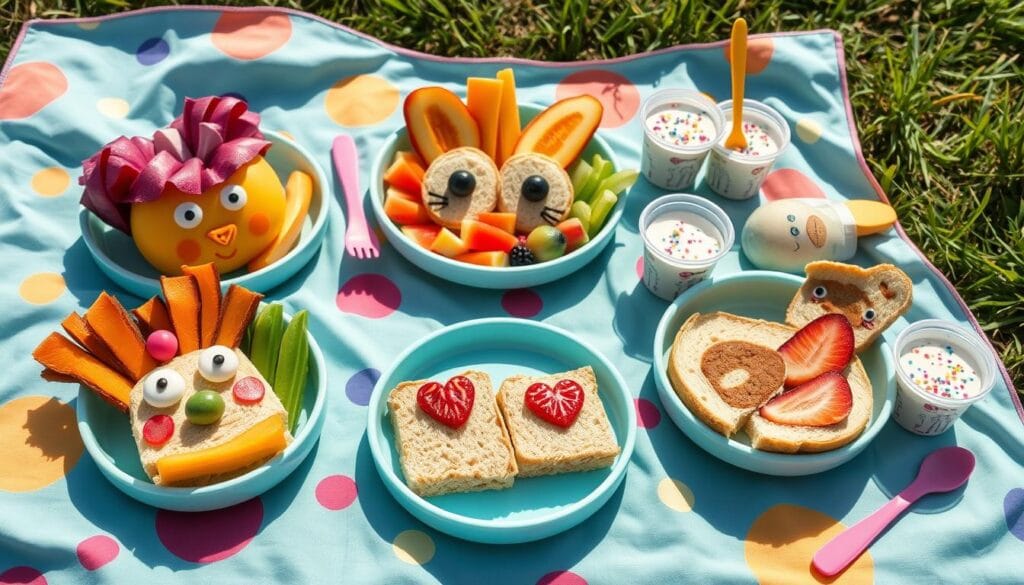
Make mealtime fun and engaging for your toddler. A little creativity can turn a simple lunch into a memorable experience that promotes healthy eating.
Packing Tips for Daycare and Preschool Lunches
Packing healthy lunches for your toddler’s daycare or preschool is rewarding. It needs careful thought on food safety and keeping things cool. By following simple tips, you can make sure your child’s lunch is nutritious, fun, and safe.
Food Safety Guidelines
Food safety is key when packing daycare lunch ideas and preschool lunch packing. Keep cold items like dairy, meat, and cooked foods in insulated bags with ice packs. For hot meals, a good thermos keeps food warm. Also, follow any food safety for kids’ lunches rules from the daycare or preschool. Don’t send foods that could cause allergies in other kids.
Container Recommendations
Choose lunch containers that are easy for your toddler to use. Bento boxes with separate sections are great for organizing food. Silicone muffin cups or small containers are perfect for snacks and sides. Pick durable, leak-proof, and safe materials.
Temperature Control Methods
Keeping food at the right temperature is vital for safety and freshness. Use insulated bags or boxes with ice packs for cold items. For hot meals, a sealed thermos keeps food warm. Reusable ice packs or frozen water bottles can also help keep things cool.
By using these daycare lunch ideas and preschool lunch packing tips, you can pack a safe and tasty lunch for your toddler. A bit of planning and creativity makes it easy to keep food safety for kids’ lunches in mind.
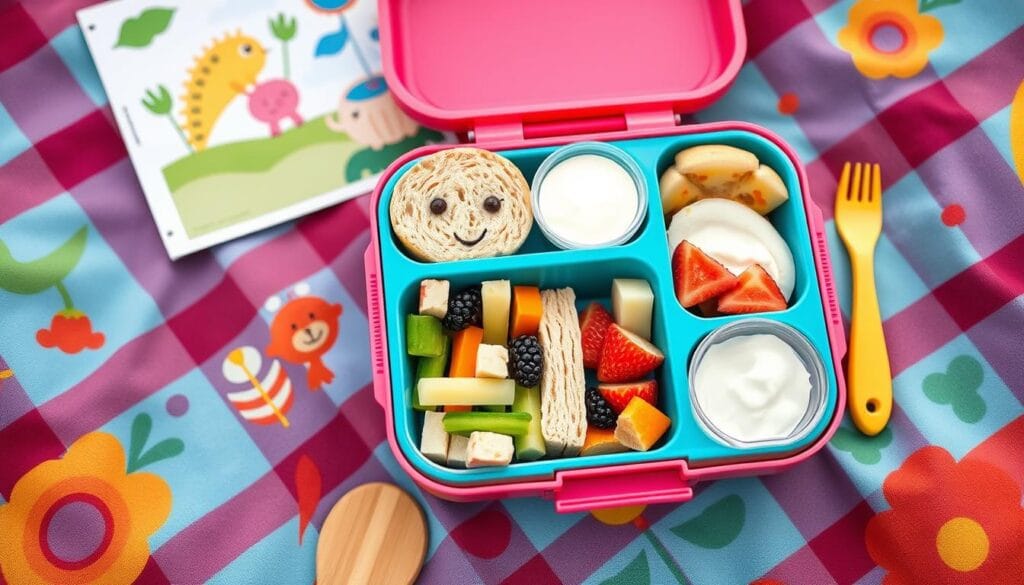
Kid-Friendly Protein and Veggie Combinations
Packing a nutritious lunch for your toddler is all about creativity. You need to mix protein and veggies in fun ways. These foods are key for your child’s growth.
Mini veggie wraps are a great idea. Layer hummus or cream cheese onto a tortilla. Add shredded carrots, cucumber, and cheese. Roll it up and cut into small pieces for a tasty lunch.
Another hit is cheese and veggie quesadillas. Place shredded cheese and diced veggies between tortillas. Serve with salsa for dipping. These quesadillas are full of protein, fiber, and healthy fats.
Try homemade chicken nuggets with sweet potato fries for a protein-rich meal. Bake them for a healthier version. You can freeze leftovers for easy lunches later.
- Hummus with veggie sticks
- Egg and cheese mini muffins
- Fruit and cheese kabobs
These simple meals ensure your toddler gets the nutrients they need. They also enjoy the flavors and textures. With a bit of creativity, you can make healthy lunches that kids love.
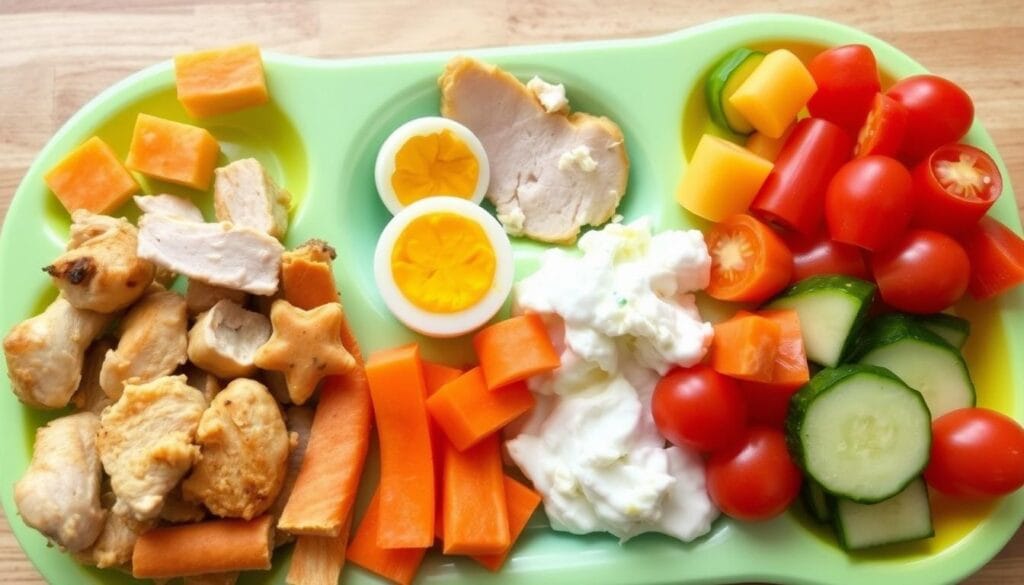
Smart Strategies for Picky Eaters
Dealing with a picky eater can be tough for parents of toddlers. However, there are strategies to encourage your child to explore new foods. One method is the deconstructed meal approach. This means breaking down meals into separate parts for your child to explore.
This approach gives your child control and makes them more open to new tastes. When introducing new foods, pair them with favorites. This makes your child feel more comfortable and willing to try new things.
Also, try making healthy versions of their favorite dishes. Add extra veggies or use whole grains. With patience, your child will start to enjoy nutritious foods.
Deconstructed Meal Approach
The deconstructed meal approach breaks down meals into parts like proteins, veggies, and grains. This lets your toddler try each part at their own speed. Start with familiar foods and add new ones gradually.
Introducing New Foods
Introducing new foods to your toddler takes time and effort. It might take up to ten tries for them to accept a new food. Pair new foods with familiar ones and show your child how much you enjoy them.
Engage your child in grocery shopping and meal preparation. This can make them more excited to try new foods.
Making Familiar Foods More Nutritious
If your child only eats a few foods, you can still add nutrition. Mix pureed veggies into sauces, soups, or baked goods. Use whole grains instead of refined ones, like whole wheat pasta or brown rice.
These small changes can make your child’s favorite meals healthier. They won’t even notice the difference.
Every child is different, and finding the right strategies takes time. Stay patient and keep offering healthy options. Involve your child in the process. With these smart tactics, you can help your toddler develop a healthy relationship with food.
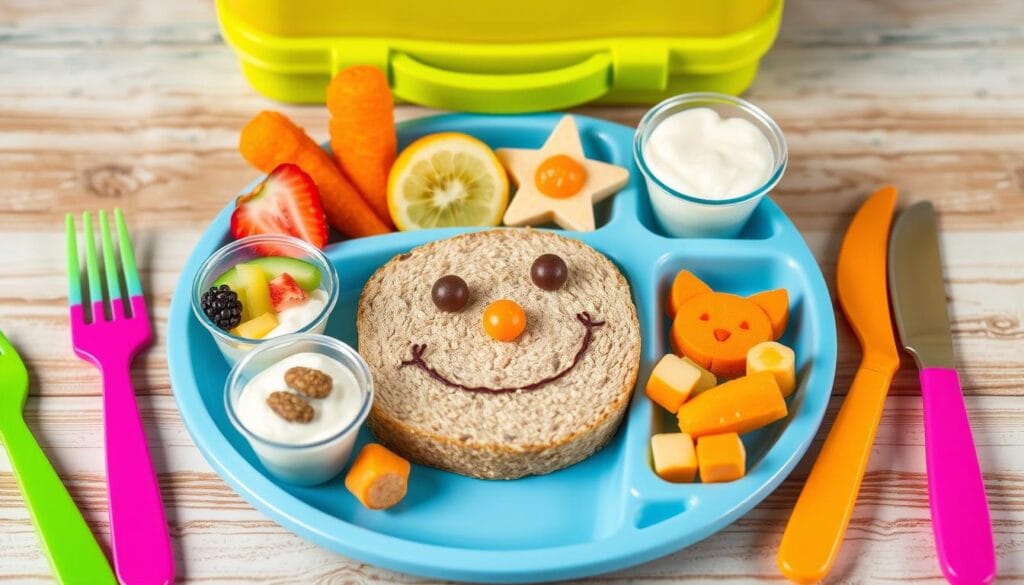
Building Healthy Eating Habits Through Lunch Choices
Lunchtime is a great chance to help your toddler develop healthy eating habits. By offering a variety of nutritious foods, you can help them try new flavors and textures. This can broaden their toddler food preferences.
Let your toddler feed themselves. This helps with their motor skills and makes them feel proud of their meals. Also, eating healthy yourself sets a good example and makes mealtime positive.
Get your toddler involved in planning and making meals. This sparks their interest in the food they eat. It also teaches them to make healthy choices.
“Children involved in selecting their lunch foods are more likely to enjoy and eat them.”
Being consistent is important for developing healthy eating habits. Try different lunches to keep things interesting and ensure a balanced diet. With creativity and patience, lunch can become a special time for your child to learn about food.
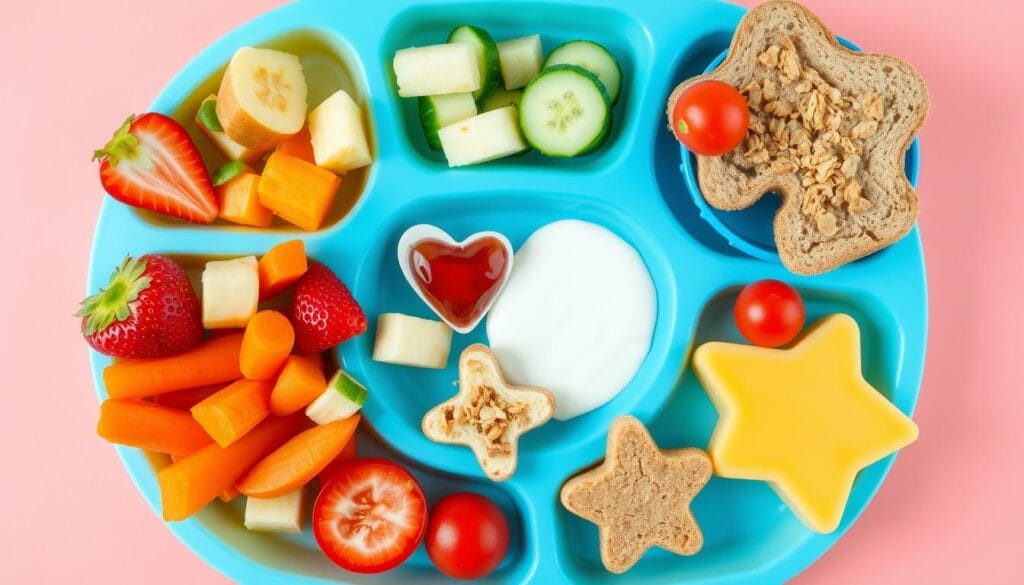
By focusing on developing healthy eating habits and toddler food preferences through lunch, you’re setting your child up for a healthy future.
Conclusion
Creating a balanced toddler diet and offering nutritious lunch ideas for kids is crucial. It supports your child’s growth and development. By focusing on key nutrients, making meals fun to look at, and providing healthy snacks, your toddler gets the vitamins and minerals they need.
Letting your child help with lunch can make them feel more in control. It also motivates them to explore new foods. Plus, using leftovers and sticking to a lunch-packing routine saves time. This way, your toddler gets a nutritious meal every day.
Don’t forget about food safety, keeping your child hydrated, and staying organized. These steps ensure your toddler has a safe and healthy lunch at daycare or preschool. By following these tips, you help your child develop good eating habits for life.

